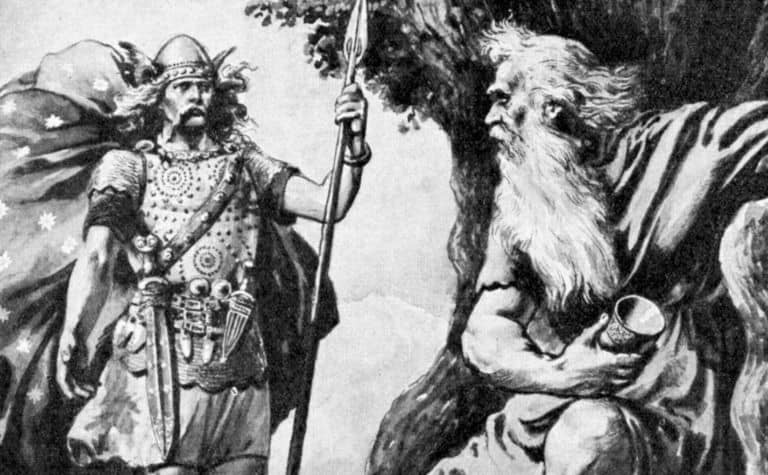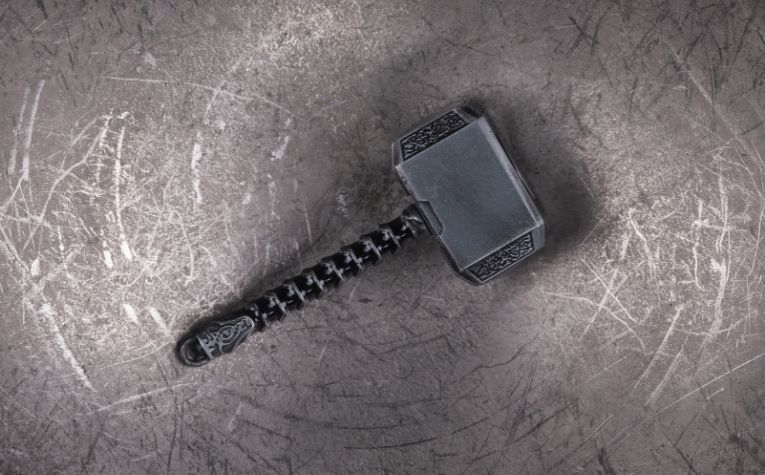Among history’s great civilizations and superpowers, the Vikings and the ancient Egyptians have each earned a lofty status.
Their great accomplishments were shaped largely by their deeply-held beliefs in the myths and legends of their people.
There are interesting parallels to be drawn between Norse mythology and Egyptian mythology, but there are fundamental ideological differences as well.
One of the most striking differences between Norse and Egyptian mythologies is how they view the universe.
The Egyptians believed that the timeline of the universe was infinite and that it would run forever. The Vikings, on the other hand, believed in the apocalyptic end of days known as Ragnarok.
Both Norse and Egyptian mythology have made immeasurable contributions to the rich tapestry that is the human story.
Just like their myths, the Vikings and the ancient Egyptians found similar ways to explain the world around them, but when it came to their respective views on life in general, they were worlds apart.
Keep reading to learn more.

Norse Mythology vs. Egyptian: Similarities
Egyptian mythology predates Norse mythology by thousands of years, but there are interesting parallels that can be drawn between the two.
These similarities show that despite living on opposite sides of the globe in vastly different times, there are certain aspects of the human condition that people have learned to accept through comparable beliefs.
Take, for instance, the similarities in their views of multiple gods.
Both Mythologies are Polytheistic: One strong parallel that runs between Norse and ancient Egyptian mythology (and quite a few others, for that matter) is that they are polytheistic or involve the worship of many gods.
Even to non-scholars or people who shy away from world history, the names of many Norse and Egyptian deities are familiar ones through mainstream pop culture sources like:
- Literature
- Cinema
- Television
- Even video games
There are dozens of gods and goddesses in the Norse pantheon of deities, but as far as the core figures that commanded most of the Vikings’ worship and admiration, this select group included the likes of:
- Odin, the all-father and god of wisdom, magic, war, and many other domains
- Thor, the god of thunder and of warriors, and perhaps the most popular of Norse gods
- Freya, the goddess of love and fertility
- Frigg, the wife of Odin and practitioner of sorcery
- Baldur, the god of beauty whose tragic death set in motion the events leading up to Ragnarok
- Loki, the trickster half-god, half-giant whose antics resulted in much chaos [1]
In the case of the ancient Egyptians, they took polytheism to the extreme.
By some scholarly accounts, there may have been as many as 2,000 gods and goddesses worshiped by the great civilization known by most as the builders of the great pyramids. [2]
The best known Egyptian deities include:
- Isis, the “mother of gods,” is by far and away the most popular and widely worshipped goddess in Egyptian mythology
- Osiris is known as the “judge of the dead,” and along with his wife, Isis is one of the original Egyptian gods
- Horus is often depicted as a human figure with the head of a hawk, and he is closely associated with the sun and sky
- Amun is the god of the sun and air and was considered during certain ancient dynasties to be the most powerful of all Egyptian gods
- Anubis is depicted as a human figure with the head of a jackal (or dog) and is closely associated with guiding the souls of the dead to the Hall of Truth for judgment
The Afterlife is Prominent in Both Mythologies
Without question, both the Vikings and the ancient Egyptians had very strong beliefs relating to the concept of life after death.
The afterlife figures prominently in both of their mythologies and is reflected in the way that they buried their dead. (Also see Is Valhalla Heaven or Hell?)
In the case of the Vikings, their belief that Valhalla awaited those warriors who died valiantly on the field of battle allowed them to fight their enemies without fear of death. It also shaped their burial practices which included:
- Cremating their dead as the smoke from the funeral pyre transported the deceased’s soul to its final destination
- Arranging burial mounds in the shape of a Viking longboat to provide safe passage of the dead to the afterlife (some wealthier Vikings were even placed in their ships which were then buried in the ground)
- Vikings were buried with their weapons and other daily implements to use in the afterlife (some were even buried with their animals and slaves) [3] (Also see Do Viking Funerals Still Happen Today?)
Like the Vikings, the ancient Egyptians believed in the afterlife. So strong were these beliefs that powerful rulers spent their entire lifetimes building pyramids to house their bodies and worldly possessions.
Other Egyptian burial practices included:
- Mummifying the bodies of their dead to provide a sanctuary for the ba and ka (two elements of a person’s soul)
- Burying the dead with shabti, small figurines representing slaves or aides who would assist the deceased in the afterlife
- Inscribing spells or incantations on tomb walls to help the deceased navigate his or her way through any pitfalls along the journey to the afterlife [4]

Norse Mythology vs. Egyptian: Differences
While different mythologies have their own nuances that correlate to their unique life circumstances, sometimes there are striking dissimilarities in fundamental ideology, and this is certainly the case between Norse and Egyptian mythology.
When it came to their views on life in general, the Vikings and the ancient Egyptians had strikingly different beliefs. (Also see Norse Mythology vs Christianity)
The Egyptians viewed life and death as part of a continuous, eternal journey, where the afterlife mirrored one’s existence in the mortal realm. [5]
The afterlife was also a reflection of how one lived one’s life.
In other words, a happy, peaceful existence on earth would be replicated after one died, but for a period of eternity, and thus, the importance of mummification and grave goods as part of Egyptian burial practices. [6]
In stark contrast, the Vikings believed that their universe was cyclical in nature.
Just as in the beginning, it was created, and then the gods and humankind lived in it, so too would it surely end, only to be renewed once more.
Such was the fate of the Norse cosmos, and the Vikings were accepting of the fact that during Ragnarok, not only would all living things perish, but virtually all of their beloved gods as well. [7]
Thus, for the Vikings, there was no eternal happiness or continuation of life after death (although there was an afterlife), only the promise of a new beginning following a fiery, cataclysmic end. (Also see Do Norse Gods Age and Die?)
When did Norse Mythology Begin?
One of the greatest challenges facing scholars of Norse mythology is the fact that it was largely based on oral traditions – the passing down of myths from one generation to the next through oral storytelling.
Because of this, the Vikings did not record their beliefs or experiences in writing.
Written materials relating to the Vikings that do exist, such as Snorri Sturluson’s Prose Edda, which is widely considered a preeminent source on Viking society and Norse beliefs, were written well after the Viking Age had ended. [8]
Scholars believe that Norse mythology was an offshoot of Germanic paganism, which itself is believed to have originated during the Iron Age (many Germanic tribes also did not maintain written records of their own history). [9]
There are strong parallels between Germanic paganism and Norse mythology, including the gods and goddesses they worshiped and mythical tales that were passed down for generations.
Thus, while Norse mythology was prominent around the Viking Age (793 – 1066), its core beliefs were rooted in Germanic myths that some believe date back to the time of Julius Caesar (100 BC – 44 BC), which would make some elements of Norse mythology more than 2,000 years old. [10] (Also see Is Norse Mythology Older Than Christianity?)
How Old is Egyptian Mythology?
Based on artwork observed in ancient tombs and what historians know about Egyptian burial traditions from thousands of years ago, it is believed that Egyptian mythology may date as far back as around 4,000 BCE and could therefore be over 6,000 years old. [11]
Scholars and Egyptologists believe that the ancient Egyptian civilization began around the year 3,000 BCE and lasted until ancient Egypt’s last ruler, Cleopatra, died by her own hand in 30 BCE, a period of nearly three millennia. [12]
Putting all of these awe-inspiring dates together makes Egyptian mythology one of humankind’s oldest collections of myths and beliefs, which is only fitting given that the ancient Egyptians are responsible for forming one of the longest-lasting and most enduring civilizations that the world has ever seen. (Also see Valhalla vs. Asgard: What’s the Difference?)
Final Thoughts
The Egyptians and Vikings lived thousands of years apart on opposite sides of the globe, and their great civilizations were largely shaped by their myths.
References:
[1] Source
[2] Source
[3] Source
[4] Source
[5] Source
[6] Source
[7] Source
[8] Source
[9] Source
[10] Source
[11] Source
[12] Source
